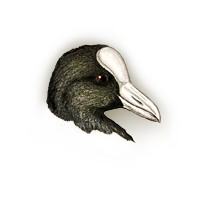|
Field
Guide IDs: BREEDING:
Freshwater lakes,
ponds, marshes, rivers. Usu 1 brood, occ
2. DISPLAYS:
Male paddles after
female, flapping wings; female dives if too closely
pressed. Male paddles with head and neck on water,
wingtips raised above, spreads and elevates tail to
display white patches. Female assumes similar
pose. NEST:
Usu over water (1
'- 4' deep), in veg tall enough to conceal; large
floating cup of dead stems on platform anchored to
veg, lined with finer materials. Other platforms
for resting/roosting, esp brood platform built
mostly by male. EGGS:
Pinkish-buff,
marked with blackish-brown. 1.9" (49
mm). DIET:
Mostly aquatic veg,
algae; also fish, tadpoles, crustaceans, snails,
worms, aquatic and terrestrial insects, eggs of
other marsh-nesting birds. Pirates plants from
ducks. CONSERVATION:
Winters s to s C.A.
Golf course and gun club pest. NOTES:
Clutch overlap
occurs during seasons when breeding starts early
enough for 2 broods. Younger birds tend to nest
later than older birds; later clutches smaller.
Brood parasitism: clutches >12 likely from >1
female. Young hatch asynchronously. Fairly common
winter visitor at Lagunita. Birds lingering into
spring may occasionally nest here. ESSAYS: American
Coots;
Piracy;
Feet;
Vocal
Development;
Variation
in Clutch Sizes;
Commensal
Feeding. REFERENCES:
Gorenzel et al.,
1982; Hill, 1986; Ryan and Dinsmore, 1979,
1980. |
